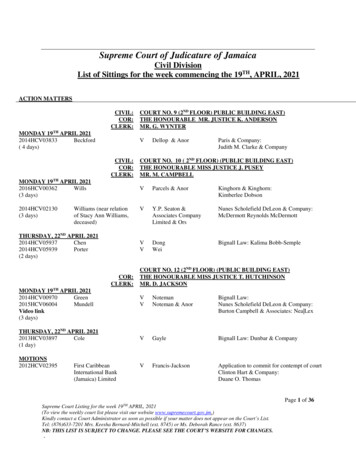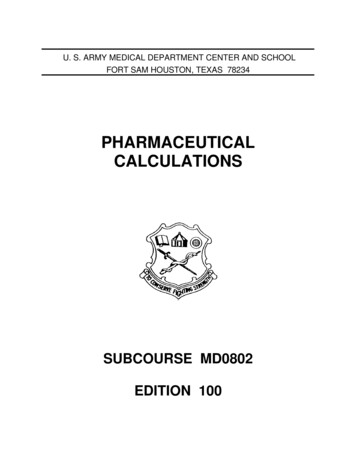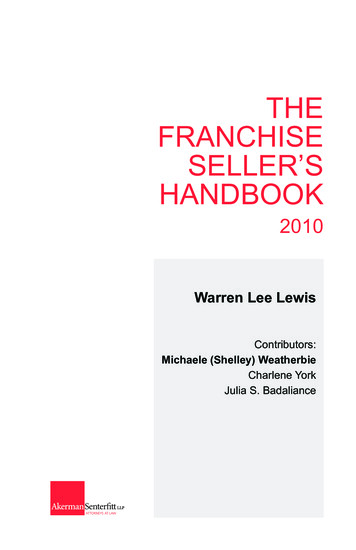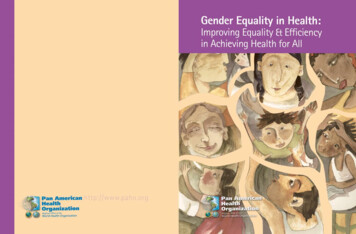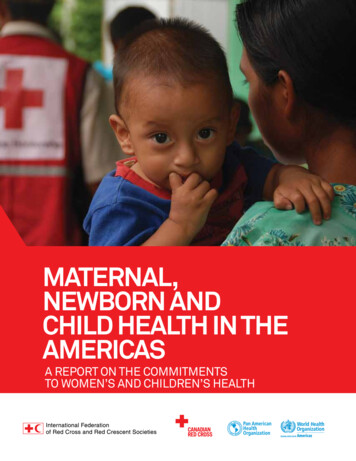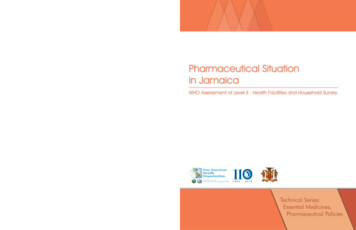
Transcription
Pharmaceutical Situation In Jamaica. WHO Assessment of Level Ii - Health Facilities and Household Sur veyISBN 978-92-75-11697-5Pharmaceutical Situationin JamaicaWHO Assessment of Level II - Health Facilities and Household SurveyTechnical Series:Essential Medicines,Pharmaceutical Policies
Pharmaceutical Situationin JamaicaWHO Assessment of Level II - Health Facilities and Household SurveyTechnical Series: Essential Medicines, Pharmaceutical Policies, Nº 5September 2012Washington, DCMinistry of Health of JamaicaMedicines and Health Technologies ProjectArea of Health Systems based on Primary Health CarePan American Health Organization
PAHO HQ Library Cataloguing-in-Publication DataPan American Health Organization, Ministry of Health of Jamaica.Pharmaceutical Situation in Jamaica. WHO Assessment of Level II - Health Facilities and Household Survey.Washington, D.C.: PAHO, 2012.(Technical Series: Essential Medicines, Pharmaceutical Policies, Nº 5)ISBN 978-92-75-11697-5I. Title.II. Series1. Pharmaceutical services2. Pharmacy administration3. Health facilities4. Data collection5. Americas(NLM Classification: WA730 DJ2)The Pan American Health Organization welcomes requests for permission to reproduce or translate its publications, inpart or in full. Applications and inquiries should be addressed to Editorial Services, Area of Knowledge Management andCommunications (KMC), Pan American Health Organization, Washington, D.C., U.S.A. The Area of Health Systemsbased on Primary Health Care, Project of Medicines and Health Technologies (HSS/MT) will be glad to provide the latestinformation on any changes made to the text, plans for new editions, and reprints and translations already available. Pan American Health Organization, 2012. All rights reserved.Publications of the Pan American Health Organization enjoy copyright protection in accordance with the provisions ofProtocol 2 of the Universal Copyright Convention. All rights are reserved.The designations employed and the presentation of the material in this publication do not imply the expression of anyopinion whatsoever on the part of the Secretariat of the Pan American Health Organization concerning the status of anycountry, territory, city or area or of its authorities, or concerning the delimitation of its frontiers or boundaries.The mention of specific companies or of certain manufacturers’ products does not imply that they are endorsedor recommended by the Pan American Health Organization in preference to others of a similar nature that are notmentioned. Errors and omissions excepted, the names of proprietary products are distinguished by initial capital letters.All reasonable precautions have been taken by the Pan American Health Organization to verify the information containedin this publication. However, the published material is being distributed without warranty of any kind, either expressedor implied. The responsibility for the interpretation and use of the material lies with the reader. In no event shall the PanAmerican Health Organization be liable for damages arising from its use.
Table of ContentsList of figures, tables and boxes. iiConflict of interest statement.viiiAbbreviations and acronyms . ixForeword. xiExecutive summary. 1Country background - Health and pharmaceutical sector.1Study.2Health facility survey .2Household survey.4Recommendations.6Introduction.7Country background. 9Health sector.10Pharmaceutical sector (12).11Study design and methods. 15Health facility survey.15Household survey.19Results and discussion . 23Health facility survey.23Household survey.32Conclusions and recommendations. 55Summary of recommendations.57References.59Annex 1. Level I Questionnaire on structures and processes of country pharmaceutical situations. 61Annex 2. Level II Survey Forms. 87Annex 3. Rounded ranges of household expenditures. 117Annex 4. Description of indicators - Health facility survey. 119Pharmaceutical Situation in Jamaica - WHO Assessment of Level II - Health Facilities Survey and Household Surveyiii
List of figures, tables and boxesFigure 1. Geographic location of all parishes of Jamaica . 9Table 1. Distribution of the Jamaica population, Jamaica, 2001-2009. 9Table 2. General profile of Jamaica, 2008-2009. 10Table 3. Pharmaceutical indicators. 12Box 1. Key medicines selected for the survey. 16Box 2. Tracer conditions for affordability and for compliance of prescribers to recommendedtreatment protocol/guideline. 16Box 3. Summary list of indicators and corresponding survey form used to collect the data. 17Figure 2. Household sampling. 20Table 4. Characteristic of the surveyed facilities. Jamaica, May 2010. 23Table 5. Characteristics of outpatients interviewed. Jamaica, May 2010. 24Table 6. Dispenser profile and compliance with the law, PSA-HFS Level II, Jamaica, May 2010. 24Table 7. Prescriber profile in the public sector, PSA-HFS Level II, Jamaica, May 2010. 25Table 8. General indicators for availability and geographical accessibility, PSA-HFS Level II,Jamaica, May 2010. 25Figure 3. Availability of key medicines in public health facility dispensaries, in private pharmacies,and in public central medical store, PSA-HFS Level II, Jamaica, May 2010. 26Figure 4. Distribution of facilities according to the percentage of prescribed medicinesdispensed or administered, PSA-HFS Level II, Jamaica, May, 2010. 27Figure 5. Average stock-out duration in public health facility pharmacies and in public centralmedical store, PSA-HFS Level II, Jamaica, May 2010. 27Table 9. Number of days’ wages of the lowest paid government worker needed to purchasestandard treatments, PSA-HFS Level II, Jamaica, May 2010. 28Table 10. General indicators for quality of medicines, PSA-HFS Level II, Jamaica, May 2010. 29Figure 6. Adequacy of infrastructure of conservation conditions of medicines, PSA-HFS Level II,Jamaica, May 2010. 29Table 11. General indicators for rational use, PSA-HFS Level II, Jamaica, May 2010. 30Table 12. Distribution of private pharmacies according to their results on % prescription medicinesbought without prescription, Jamaica, May 2010. 31Table 13. Adherence of prescribers to recommended treatment guidelines, PSA-HFS Level II,Jamaica, May 2010. 31Figure 7. Number of surveyed households in each region, Jamaica, 2010. 32Figure 8. Age of respondents/health care decision makers, Jamaica, 2010. 33Table 14. Education of respondents, Jamaica, 2010. 33Figure 9. Household assets and levels of monthly (4 weeks) expenditures, Jamaica, 2010. 34Table 15. Monthly household expenditures, Jamaica, 2010. 35Table 16. Characteristics of households, Jamaica, 2010. 36Pharmaceutical Situation in Jamaica - WHO Assessment of Level II - Health Facilities and Household Surveyv
Table 17. Sources of income and the job of the main earner in the household (household head),Jamaica, 2010. 36Table 18. Prevalence of acute and chronic conditions, Jamaica, 2010. 37Table 19. Characteristics of acute and chronic conditions, Jamaica, 2010. 37Figure 10. Reported symptoms and perceived severity of acute illness, Jamaica, 2010. 38Figure 11. Most frequent chronic diseases by gender, Jamaica 2010. 38Figure 12. Prevalence of illnesses, Jamaica, 2010. 39Table 20. Travel time to closest health care facilities in Jamaica, 2010. 40Figure 13. Households far away from a public health care facility. 40Figure 14. Sources of medicines found in households, Jamaica, 2010. 41Figure 15. Sources of medicines taken for an acute illness, Jamaica, 2010. 41Table 21. Opinions about geographic access and availability of medicines, Jamaica, 2010. 42Table 22. Cost of prescription for a recent acute illness, Jamaica, 2010 . 43Table 23. Monthly cost of medicines for a chronic disease, Jamaica, 2010. 43Figure 16. Potentially catastrophic expenditures related to medicines in month preceding survey,Jamaica, 2010. 44Table 24. Medicines free-of-charge and insurance coverage. 44Table 25. Opinions about affordability of medicines. 45Figure 17. Medicines in households and in households with children, Jamaica, 2010. 46Figure 18. Percentage of home medicines with adequate label, primary package and validity, bysource, Jamaica, 2010. 47Table 26. Actions taken for a recent acute illness, Jamaica, 2010. 48Figure 19. Prescribers of medicines in case of acute illness, Jamaica, 2010. 48Figure 20. Route of administration of medicines prescribed for acute illness, Jamaica, 2010. 49Figure 21. Reasons for not taking prescribed medicines for acute illness, Jamaica, 2010. 50Figure 22. Actions taken for chronic diseases, Jamaica, 2010. 51Figure 23. Reasons for not taking medicines prescribed for a chronic disease, Jamaica, 2010. 51Table 27. Opinions about quality of care and generics, Jamaica, 2010 . 52Table 28. Availability of medicines in households with at least one acute or chronic condition,Jamaica, 2010. 52Table 29. Affordability of medicines in households with at least one acute or chronic conditions,Jamaica, 2010. 53Table 30. Households with at least one acute or chronic conditions - Access to medicines - Mixedindicators, Jamaica, 2010. 53Table 31. Access to medicines in all households. 53viTechnical Series: Essential Medicines, Pharmaceutical Policies, No. 5
AcknowledgementsThis WHO Pharmaceutical Situation Assessment (PSA), Level II, was conducted with the fullsupport of the Ministry of Health (MOH) of Jamaica, including their permission and endorsementto conduct the study, with the technical and financial support from PAHO/WHO through the EU/WHO ACP Project “Partnership on Pharmaceutical Policies.”Princess Osbourne, Director of Standards and Regulation Division/MOH, was the main investigator, Cynthia Lewis Graham, MOH was the Lead Coordinator and Andre Dennis, MOH the Assistant Coordinator. Area supervisors were Sherna Williams-Bell, Jennielyn O’Connor-Guy, JudithAtkinson-Linton, Kerryann Palmer-Black and Andre Dennis.The data collectors were:Health Facility Survey: Joseph Laing; Andre Brown; Kashif Walker; Tahira Howell; OmarGreen; Terry-Ann Waite; Dianery Morgan; Camille Rose; Meisha-Gaye Howell; Jheanette Watson; Tashoya Bent; Andre Forbes; Trecia Forbes; Damion Barnes; Francene Leiba; Cameca Williams; Colleen Blake; Cathryn Belcher; Sherida Sterling.Household Survey: Josie-Ann Graham, Trishana Dunbar, Monique Cameron, KimberleyVaccianna, Terry-Ann Waite, Omar Green, Horace Green, Michielee Black, Melissa Reid, DavidBuckingham, Michael Gordon, Andena Peart, Jody-Ann Campbell, Peta-gaye Aitcheson, DwightDunkley, Cheree Campbell, Warren Wright, Christopher Abraham, Lloyd Graham, Debbie-AnnMcFarlaneThe data entry, analysis and report editing team included Hank Williams, Tennien Black, Tisannia Tam, Kemoya Stewart and Andrew Bennett.The support of the directors/heads of health facilities and departments in all five survey areaswas fundamental to make the study possible.Vera Lucia Luiza and Paula Pimenta, from the PAHO/WHO Collaborating Centre on Pharmaceutical Policies from the Sérgio Arouca National School of Public Health/Oswaldo Cruz Foundation (NAF/ENSP/Fiocruz), facilitated the training of data collectors and data entry personnel andprovided technical support; Adriana Ivama, Medicines and Biological Sub-regional Advisor, CPC/PAHO/WHO, provided technical support, reviewed and supported the publication of the report.Nelly Marin Jaramillo, Regional Advisor on Pharmaceutical Policy, PAHO/WHO, coordinated theprocess in the Americas and facilitated the support; Enrico Cinnella, technical officer from theEssential Medicines and Pharmaceutical Policies Department, WHO, reviewed the report. TassiaWilliams, PAHO/WHO CPC form intern, did proof reading. Ms. Marilyn Entwistle, PAHO/WHOJamaica, facilitated the final review of this report; their assistance is gratefully acknowledged.Pharmaceutical Situation in Jamaica - WHO Assessment of Level II - Health Facilities and Household Surveyvii
Acknowledgement/disclaimerThis document has been produced with the financial assistance of the European Union andthe technical support of the Pan American Health Organization/World Health Organization. Theviews expressed herein are those of the authors and can therefore in no way be taken to reflectthe official opinion of the European Union (EU) or the Pan American Health Organizaton/WorldHealth Organization (PAHO/WHO).Conflict of interest statementNone of the authors of this survey or anyone who participated or collaborated in any phaseof the planning, field work, analysis or interpretation of the results had any competing financial orother interests.viiiTechnical Series: Essential Medicines, Pharmaceutical Policies, No. 5
Abbreviations and NNJ JRDURHARUMSESSFSTATINSTGSTItabtdUNDPUNICEFAfrican, Caribbean and PacificAcute respiratory infectionBis die (Latin for “twice a day”)Central Intelligence Agency (of the United States of America)Caribbean Regional Drug Test LaboratoryDevelopment Human IndexDrugs and Therapeutics CommitteesEssential Medicines ListEuropean UnionGross domestic productHealth Corporation LimitedHealth Facility SurveyIntegrated management of childhood illnessInternational Non-proprietary NameJamaican dollarJamaica Drugs for the Elderly ProgramMilligramsMilliliterMinistry of HealthCenter for Pharmaceutical Policies/Sérgio Arouca National Schoolof Public Health/Oswaldo Cruz Foundation (Núcleo de AssistênciaFarmacêutica/Escola Nacional de Saúde Pública Sérgio Arouca/Fundação Oswaldo Cruz)Non-governmental organizationsNational Health FundNational Medicines PolicyNational Pharmaceutical PolicyOral rehydration saltsPan American Health OrganizationPlanning Institute of JamaicaRational drug useRegional Health AuthorityRational use of medicineSocioeconomic StatusSurvey FormularyStatistical Institute of JamaicaStandard Treatment GuidelinesSexually transmitted diseaseTabletTwice dailyUnited Nation Development ProgramUnited Nations Children’s FundPharmaceutical Situation in Jamaica - WHO Assessment of Level II - Health Facilities and Household Surveyix
URTIUS UTECHUWIUTIVEN ListWHOxUpper respiratory tract infectionUnited States dollarUniversity of TechnologyUniversity of the West IndiesUrinary tract infectionVital, Essential and Necessary ListWorld Health OrganizationTechnical Series: Essential Medicines, Pharmaceutical Policies, No. 5
ForewordIn consonance with Ministry of Health’s mandate of “Ensuring the provision of quality healthservices and to promote healthy lifestyles and environmental practices,” I am honoured to presentthe results of the Pharmaceutical Situation Assessment in Jamaica. The publication report wasdeveloped with the technical and financial support from the collaboration of the Pan-AmericanHealth Organization/World Health Organization (PAHO/WHO), through the EU/WHO ACP Project“Partnership on Pharmaceutical Policies” and The Centre for Pharmaceutical Policies of the Oswaldo Cruz Foundation in Brazil, PAHO/WHO Collaborating Centre on Pharmaceutical Policies.The publication report reflects the efforts of the Ministry to provide to the Jamaican citizensmedicines of ensured quality and safety and to promote their rational use. The gaps identified arean important resource to inform the development of the National Pharmaceutical Policy. Importantly, it will facilitate the efforts of the Ministry of Health, its Agencies and related organizations,to continue improving the quality of care across the island.Hon. Dr. Fenton FergusonMinister of HealthPharmaceutical Situation in Jamaica - WHO Assessment of Level II - Health Facilities and Household Surveyxi
Executive summaryCountry background - Health and pharmaceutical sectorThe island of Jamaica lies about 885 km south of Miami, 145 km south of Cuba and 161 kmwest of Haiti and is located almost at the centre of the Caribbean Sea. It is the largest of theEnglish-speaking Commonwealth Caribbean Islands, and the third-largest island in the regioncovering an area of 10,999 km2. The island is divided into three counties and subdivided into 14parishes.The population of Jamaica in the year 2006 was 2,673,816. The population growth rate was0.5% and the total fertility rate was 2.5% and females represented 50.7% of the population. Thecrude birth rate was 17.04 per 1,000 of population. Infant mortality rate was 19.99 deaths per1,000 live births. Life expectancy at birth was 73.12 years and 32.5% of the population was belowthe age of 15 years. The average population density was estimated at 660 per square miles and48% of the population lived in the rural areas.Healthcare in Jamaica is provided by the Ministry of Health (MOH), the private sector andother non-governmental organizations. The health system offers primary, secondary, and tertiarycare services. Approximately 38% of the population utilizes the public sector for ambulatory care,57% use the private sector, and 5% use both sectors. Private hospitals only handle about 5% oftotal hospital services. Public hospitals handle the most complicated and costly cases.The Standards and Regulation Division of the Ministry of Health (MOH), administers the Foodand Drug Act of 1964, and Regulations of 1975, and thus provides the authorization for manufacturing, importation, distribution and use of pharmaceuticals. The Division ensures that all substances used as food, drugs, and cosmetics are efficacious, safe and of high quality. Jamaicadoes not have an officially adopted National Pharmaceutical Policy. There is a draft for submission to Parliament.The first national essential medicines list—Vital, Essential, and Necessary (VEN) List of medicines—developed to guide the procurement and rational use of pharmaceuticals was publishedin 1988. It has undergone several subsequent reviews, on an average biannual basis and the lastreview was in December 2008. This document embraces the concept of rational drug use andserves as a guide to doctors, nurses, pharmacists, and students of these disciplines in the publichealth sector. The VEN List assists the maintenance of rational prescribing practices in publicfacilities. The third edition of the National Drug Formulary was issued in 1997.Health Corporation Limited (HCL), a quasi-private company established in 1994 to ensure theefficient, cost-effective procurement and distribution of pharmaceuticals and medical supplies,has met approximately 70% of the essential needs of the public sector. In 2010, the HCL wasmerged with the National Health Fund (NHF). The public expenditure on medicines (2006/07)was 680,094,000 Jamaican dollars (J ) (US 7,654,406.30), representing J 254.35 (US 2.86)per capita. In 2007, there were 516 pharmacies [117 public (83 in operation), and 399 private], 9private manufacturers and 23 medicines distributors (1 public and 22 private).Pharmaceutical Situation in Jamaica - WHO Assessment of Level II - Health Facilities and Household Survey1
StudyThe assessment of the pharmaceutical situation, Level II, was undertaken in Jamaica fromJuly, 2009 to May, 2010 using a standardized methodology developed by the World Health Organization (WHO). The goal of the assessment was to evaluate the pharmaceutical situation inJamaica using outcome indicators. More specifically, the study collected information on access,affordability and availability of key medicines and geographical accessibility of dispensing facilities and rational use of quality medicines, as well as some data on the quality of medicines athealth facilities and pharmacies. All this information was then used to evaluate whether the goalsset for the pharmaceutical sector are being achieved.The study has two components, both indicators based: health facilities and households survey. In the first approach, data related to the pharmaceutical policy outcome was collected frompublic healthcare facilities, public and private pharmacies and the public warehouse that supplypublic facilities. In the second, data came from a survey conducted at household level.Health facility surveyMethodsThe survey was conducted in five areas: North Eastern Region, South East Region – A, SouthEast Region – B, Southern Region and Western Region. In each survey area, 5 to 6 public healthcare facilities and 2 to 6 private pharmacies were surveyed. In the country 1 public warehousewas surveyed.In each facility surveyed, a set of survey forms (Annex 2) was applied. The survey commenced following ethical approval from the Ministry of Health’s Ethics Committee. Local healthmanagers were contacted for specific local approval and cooperation. The country was dividedinto five survey areas with a team of workers for each one. Field teams comprised 19 data collectors each (pharmacy interns), selected according to the region to which they were assignedfor rotation; and 5 supervisors (regional or senior pharmacists) who oversaw data collection andverified the quality of the data collected. Data collection methods included patient and healthworker interviews after oral consent, check list guided observation and clinical and administrativedocuments review. Data collection took place between January 25 and March 19, 2010.Data entry was performed using designed summary forms. Analysis was done using Excel program.Key resultsAccessOverall access indicators show that key essential medicines are largely available in publichealth facilities (93.3%), warehouses that supply the public health system (100%) and privatepharmacies (93.3%). The average length of stock-out duration in public health facilities was 23.1days, whereas in the warehouse it was only 8.1 days, which indicate that this picture is not stablealong time. Due to good availability, most prescribed medicines (76.7%) were found as dispensedin the cross sectional approach.2Technical Series: Essential Medicines, Pharmaceutical Policies, No. 5
Concerning geographical accessibility, few of the patients interviewed at public dispensingfacilities and private pharmacies have to travel more than one hour to reach the facility.In treating common conditions [hypertension, diabetes, urinary tract infection (UTI), worm infestation] using standard regimens, the lowest paid government worker would need between 0.1(diabetes) and 0.8 (hypertension)1 days’ wages to purchase lowest priced generic medicines fromthe private sector. In the private sector, once originator brands are chosen, costs are higher andthe number of days’ wages necessary to purchase treatment vary from 0.4 (worm infestation) to5.2 (hypertension). In the public sector, the medicines are provided free of charge for all conditions chosen.Data suggests that affordability of treatment for common primary health problems is a largeproblem when the medication is not available in the public facility, since the burden for the lowestpaid public servant in terms of working days is high for common diseases like hypertension.Quality and regulationTen percent of the public dispensaries had expired medicines. Storage conditions varied from70% of adequacy in the storerooms of public health facilities to 90% of adequacy in warehousessupplying the public sector.Most of the private pharmacies comply with the law that requir
Pharmaceutical Situation In Jamaica. WHO Assessment of Level Ii - Health Facilities and Household Survey ISBN 978-92-75-11697-5 Pharmaceutical Situation in Jamaica WHO Assessment of Level II - Health Facilities and Household Survey . from the PAHO/WHO Collaborating Centre on Pharma - ceutical Policies from the Sérgio Arouca National School .

